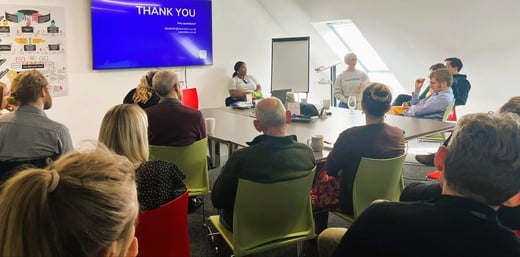
42 Technology helps ‘Beat the Heat’ for new IoT products
July 2021

Jonathan Pallant, senior embedded systems engineer at 42 Technology, was one of four guest speakers at a recent online event designed to help update engineers on the latest technologies and strategies to cut power consumption within new IoT devices.
The ‘Beat the Heat’ panel discussion included speakers from NXP, Blackberry QNX and Rohde & Schwarz, and was part of the US event Sensors Innovation Week: Summer Edition (22 to 24 June).
The four panellists were asked for advice on areas such as: how to integrate more sensing technologies into smart buildings while still meeting a company’s sustainability goals; what factors designers should consider first when targeting low power; and how autonomous vehicles can best take advantage of cloud computing capabilities without impacting their safety.
Jonathan’s suggestions included:
- Looking at the whole product life-cycle. Because there’s little point in designing an ultra-low power connected device if it’s incredibly resource intensive to manufacture it.
- Thinking about what the system needs to do. And then deciding which components you need to wake up, work with and then power down, or if a particular task can be processed with a lower power core.
- Specifying the right chip for the job. For example, by using a microcontroller to perform a particular task or by specifying a chip that does exactly what you need without any extra features or functions.
The speakers were also asked what level of technical documentation they needed when working with increasingly sophisticated system components, such as wireless modules, and where datasheets can be thousands of pages in length.
Jonathan explained that he’s worked with some great tools developed by the Rust Embedded Working Group that can auto generate a first layer driver, based on an electronic data file description of the device.
Using time-saving tools such as these means I can be confident all the lower-level details and addresses have been taken care of. In other words, they allow me to focus on tasks higher up the design and to use detailed system-level engineering and application know-how to optimise for power consumption, system performance and cost.
Listen to the panel discussion:
If you need any specific advice to help with one of your own IoT developments then please get in touch via answers@42T.com
Share this article:
Related Articles

Innovation, Connectedness
Laser Focus World publishes Dr Euan Smith's article

Innovation, Connectedness
42T’s Dr Euan Smith presents breakthrough colour measurement tech at Display Week 2024

News, Company Announcements
42T organises awareness activities during Neurodiversity Celebration Week

What will you ask us today?
We believe in asking the right questions to drive innovation; when we know the right questions, we generate the ideas to answer them.

